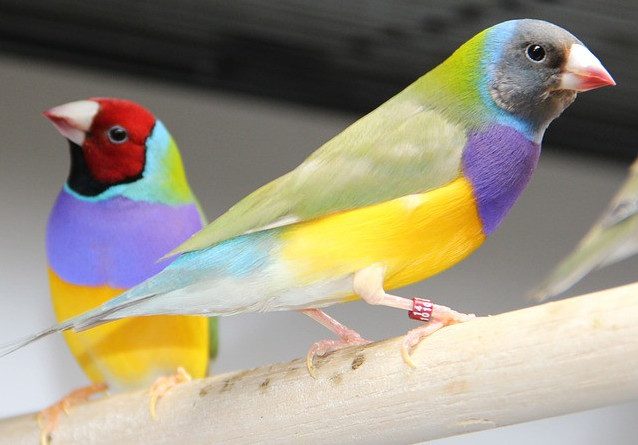Contents
Birds can be perfect pets for our older loved ones
Which birds make good pets for elderly people? Some birds just naturally attract everyone, including senior citizens.
By now, most of us know those companion animals provide an important function for our elderly loved ones. Usually, we think of a dog or perhaps a cat for that companionship. However, some find feathered friends more to their liking.
Read about how pets benefit our elderly loved ones.
While some elderly might prefer a furry friend, pet birds hold a special place in the hearts and homes of many. When we consider the needs of a pet, some types of birds need much less daily care than those popular dogs and cats. In fact, the beautiful songbirds often fill the companionship void without the expense and work that our fur-friends require.
The Benefits of a pet bird include…
- For seniors with limited mobility and resources, birds provide a good option. They require minimal clean-up and maintenance. Most smaller pet birds provide a wonderful source of relaxing background noise to a sometimes too quiet home.
- For seniors who normally stay-at-home, birds offer constant companionship. As a bonus: they tend to sleep at night and provide active companionship during the daytime. This may help keep a regular sleep schedule for the elderly.
- With a few exceptions, birds provide an option for people who are allergic to the fur or dander produced by dogs, cats, or rodents. (see exceptions below)
- Birds with smaller cage requirements can often be kept in living arrangements such as small homes, apartments, or condos. They also provide companionship in assisted living or nursing homes that don’t allow cats & dogs.
- Smaller birds cost less to initially acquire compared to cats & dogs. On-going maintenance costs are lower, as well.
- Experts and most others consider the singing, twittering, and talking of birds as therapeutic background noise. It is believed to be both calming and stimulating to the mind
And which birds make good pets for our elderly family members?
To determine which birds make good pets for our senior loved ones, consider the needs and abilities of the prospective bird owner. For a person who lives alone or wishes for some chattering, the tiny finch might be a good choice. They provide song vocals and chatter, but none of the high-pitched shrieks that larger parrot types often do. They won’t talk, but their soft, sometimes peppy voices provide a welcome addition to quiet homes.
However, don’t overlook the additional benefits of these tiny wonders. While nearly all prefer not to be handled, they provide beauty and interest as they fly from one area of their cage or aviary to another. Similar to watching our wild flying friends, observing pet birds offers many health benefits. Such advantages include potentially lowering blood pressure and helping to avoid stress and depression.
Read The Eden Magazine Article
Many caretakers note that have a small aviary within a retirement community or nursing facility provides these health benefits, too. Since small birds are easy to care for and provide such great benefits, why not explore the options for your loved one?
Which birds make good pets?
Choosing the right type of bird
Consider the needs and abilities of your senior loved one and your entire family.
- Is your loved one able to provide any care such as feeding and cleaning the cage?
- Would he or she want a pet that enjoys being held?
- Does your loved on want a bird that sings, talks, or one that is mostly quiet?
- How much room do you have for a cage or aviary?
- What is your budget for purchasing and continued care?
- Are allergies a consideration?
- Who will care for the bird if it outlives your loved one?
As you read on, we’ll provide pointers with each type.


Canary
Usually thought of as yellow birds, the canary may also be orange to red or brown. They possess a variety of singing voices and only the male is considered a singer. However, females also provide some quieter chatter that is also interesting.
Most canaries remain happiest in a large cage or aviary. Occasionally, one takes to being held, but it is not likely.
But usually, the canary is loved for its beautiful coloring and equally endearing voice. They also are quite active, making them enjoyable to watch. While a large cage suffices, you will find the birds most active and interesting in an indoor aviary setting. Since they are not inclined to chew, they do well with a decorative aviary. Consider a few plants to make it naturally beautiful!
The canary birds love attention from their people but prefer not to be handled, with rare exceptions. They live up to 10 years in captivity, making them a good choice for a companion pet.
Physical Characteristics
Length: 5 to 6 inches
Weight: 1/2 ounce
Color: Bright yellow, muted yellow, whitish, orange to reddish, or a variegated brown
Lifespan: up to 10 years
Speech: singing, chirping but no words or mimicking

Zebra Finch

Gouldian Finch

Java Finch
Finch
Finches tend to be quite social and do best kept in small flocks of at least 3 to 4 birds. While some will interact with their human companions, most are quite happy to have other finch as buddies. They chat with each other, fly around together, and generally engage in a very active bird-centered social life.
Although they may successfully live in a large cage, these birds come into their full beauty in an aviary or flight cage. Here, they freely stretch their wings and show amazing personalities.
Most people think of the Zebra Finch when considering the species. And Zebra Finches make great companions. Sporting the normal color with many color mutations available, Zebra Finch grace the home quite well.
However, the Finch category is quite diverse. You might consider the Cordon bleu Finch, the quieter Java Rice Finch, or perhaps the Strawberry Finch.
Physical Characteristics
Most Finch species are small, usually under 6 inches. However, the long-tail varieties will be slightly longer. Available in many different colors and patterns, finch are one of the more diverse species.
Speech: singing, chirping but no words or mimicking

Budgie (parakeet)

Budgie

Budgie
Budgies, also known as Parakeets
Most people know the budgie, commonly called a parakeet. In fact, it might be the most popular of the smaller pet birds. They are colorful and can become quite attached to their human buddies.
Budgies color varieties and bonding ability make them good pets for the senior person with a little time to devote to their feathered friend. They can learn to speak, some better than others.
Some parrot-type birds scream loudly, causing owners. But not the budgie. Their vocals vary a bit but never attain quite the scream of the large parrots.
As social birds, parakeets are best kept in pairs or groups, unless the humans intend to bond tightly with them. If one budgie will be the human’s pet companion, you should consider getting just the one to begin with. However, keeping a small group in an aviary or flight cage provides great enjoyment, too.
Physical Characteristics
Length: 7 inches
Weight: 1 ounce
Colors: colors may be: blue, gray, green, white, violet, yellow/blue, or a combination with white.
Lifespan: up to 10 years
Speech: Chirp, low vocals. some speech and mimic ability
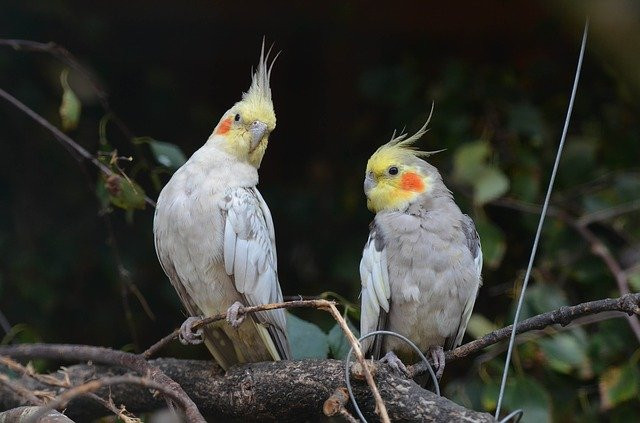
Cocatiels
Cockatiels
These medium-sized bird

cockatiel
s have quite incredible whistling and singing capabilities. Many learn to talk but often prefer to whistle and mimic sounds they hear such as a phone, alarm, or bell. While the common color is gray, many color and pattern mutations have developed through the generation.
Cockatiels do well in a large cage but do require social time with their people or with another Tiel. Without any socialization, they can become loud screamers or very depressed.
Bite warning: Hookbills can bite. The bite of a cockatiel can cause bruising or bleeding.
Physical Characteristics
 Length: 11 to 12 inches
Length: 11 to 12 inches
Weight: 2.5 to 3.5 ounce
Colors: Normal color: Light gray body with long, dark gray tail, yellow and gray crest, yellow face; orange ear patch and white on the wing; dark gray bill. Mutations include cinnamon, lutino, pied, pearl, and more.
Lifespan: 10 to 14 years
Speech: Chirp, low vocals. speech and mimic ability. can be loud
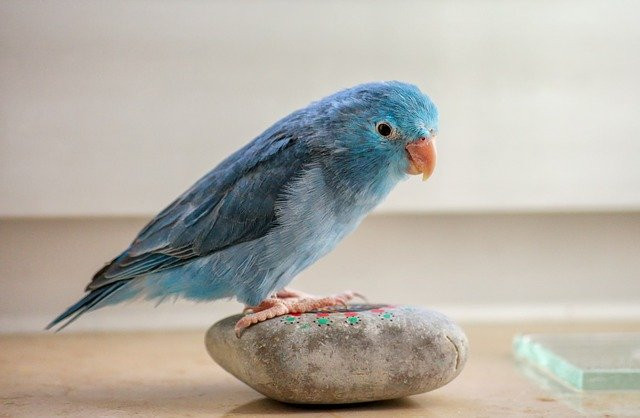
Parrotlet
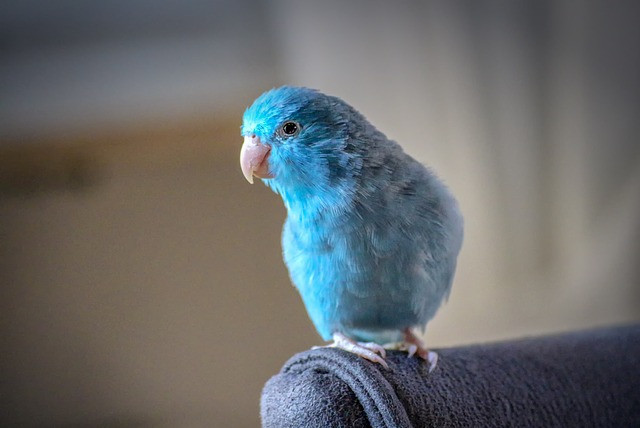
Parrotlet
Parrotlets
The Parrotlet is a tiny bird with a big personality. Closely related to the macaws, they offer companionship with a bit of character. In fact, some can be quite sassy, while others are very endearing.
While they are quite active, they are rarely loud. This tiny little feathered clown makes an ideal companion for those in apartments or nearby neighbors. Their entertaining antics might include hiding in a shirt pocket, rolling up into a towel or scarf, or even dancing for you. Parrotlets learn their name and often a few verbal cues, too.
Physical Characteristics
Length: 4 to 5 inches
Weight: 1 ounce
Colors: Green body on the normal colored. Mutations include lutino, blue, albino, and more; tiny tails, zygodactyl feet: two forward-pointing toes and two rear-pointing toes
Lifespan: 15 to 20 years, some as much as 30 years
Speech: Chirp, low vocals. fair to excellent speech and mimic ability. usually not loud

Lovebirds

Lovebirds (Peach-faced)
Even when kept in pairs or small groups, lovebirds chatter quietly. This makes them a match for those who live in apartments or with nearby neighbors. However, they can be assertive and sometimes nippy. Like parrotlets, these colorful little birds possess all the intelligence and personality of the largest of macaws. They may be opinionated, but offer plenty of entertainment.
While the more common variety is the peach-faced lovebird, the genus contains 9 known species. Only some of these are available to the pet trade, including the Fischer’s Lovebird.
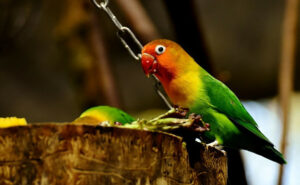 Physical Characteristics
Physical Characteristics
Length: 5 to 6 inches
Weight: 2 ounces
Colors: Mostly green, orange upper body and head, blue lower back and rump, red beak, white eye-rings.
Lovebirds make delightful pets when kept in an aviary, flight cage, or large pet cage. They can be endearing pets when handled frequently but might become less tame and even possibly nippy if not handled frequently.
These outgoing little clowns will happily chat with anyone and often learn a few tricks. They love attention, whether they are being handled or kept as an aviary bird.
Which Birds Make Good Pets for your elderly loved ones?
The birds we’ve discussed generally make good pets, if their personality is matched to the person and the bird’s needs are met. In fact, our list includes only a few. Some might find the medium-sized keets such as the Rosella to be a favorite. With a large enough aviary and sufficient time, many other species might be considered.
Whichever bird you choose, remember that most prefer a companion. If they will be an aviary or cage kept pet, it might be best to have a pair or group. However, if the bird will be handled daily and you desire him to bond closely with his person, a single bird might be best.

